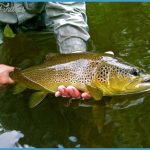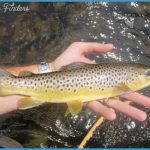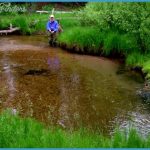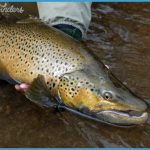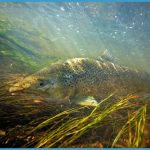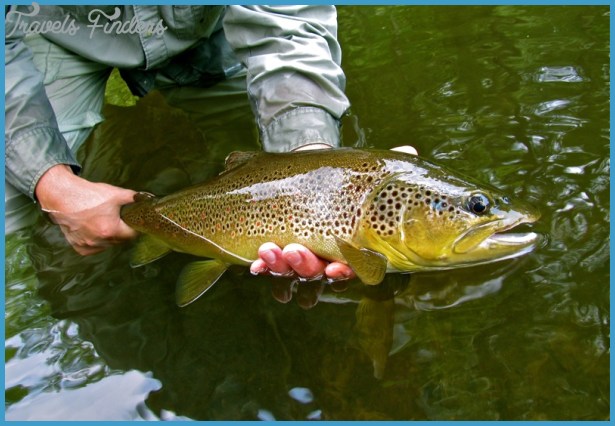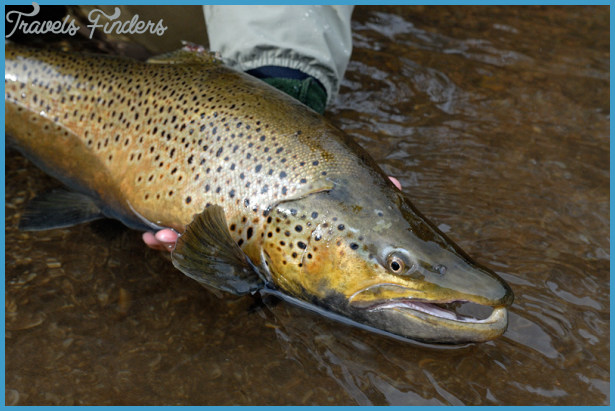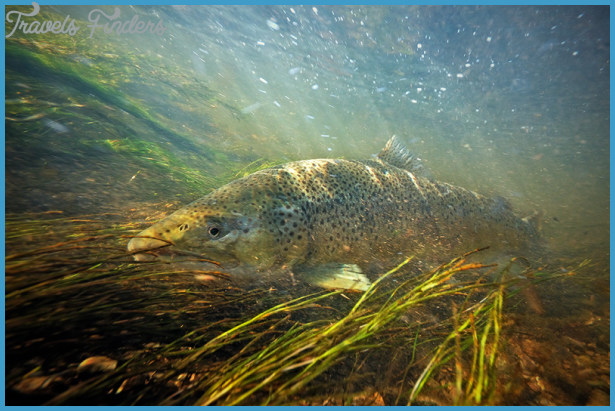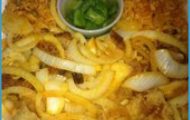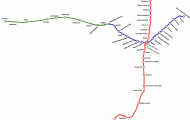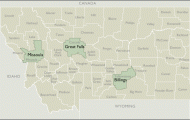Brown trout, Salmo trutta, are not new to Maine waters, but until about 25 years ago, few Maine anglers knew how to catch them and even fewer cared to learn. Brook trout, the undisputed king of Maine salmonids, received top billing. Relegated to a few rivers and a handful of lakes, brown trout lived and died without fanfare. But today, brown trout are a favorite game fish.
Maine has an immense number of lakes, ponds, rivers, and streams that are not suitable for brook trout because of warm temperatures and the presence of predators. Many of these waters are suitable for brown trout, however, and are being managed for this species.
Maine brown trout represent the fishing challenge of the modern age. Plentiful and inclined to grow much larger than the native species, browns are currently being stocked in all Maine counties except Penobscot County.
Brown trout are not pushovers like native brook trout. The angler who does not use stealth will often fail to interest even one brown trout during a day’s fishing. Another angler, fishing the same water but schooled in the ways of brown trout, may have the best fishing of his life.
Maine brown trout can be divided into two categories: stream or river fish and flatwater fish. Flatwater brown trout fishing in a placid section of a slow-moving stream is essentially the same as fishing a pond or lake. One further division may be added: anadromous brown trout. Some Maine rivers host runs of sea-run brown trout. These runs occur in the fall and early winter and techniques for these fish are the same as for any other brown trout.
Brown trout, especially the sea-run variety, can be mistaken for landlocked or Atlantic salmon. There are several ways to tell the difference between the two species. The tail of a young salmon is more deeply forked than that of a brown trout. The caudal peduncle, that area between the adipose fin and tail, is thin and tapered on a salmon. Brown trout have thick, stocky caudal peduncles. The best and most positive way to tell salmon from adult brown trout is by checking the vomerine teeth, that row of teeth in the center of the roof of the mouth. Adult brown trout have a crooked double row of vomerine teeth, while salmon have a rather straight, single row. The Maine record, a 23-pound, 8-ounce brown trout, was taken from 910-acre Square Pond in Acton in 1996. This pond has no boat landing, nor has it been stocked with brown trout in recent years. The previous Maine record brown trout weighed 19 pounds, 7 ounces, and was taken from Sebago Lake in 1958. Compare these weights with the alltime world record of 35 pounds, 15 ounces, and you will see that Maine has the potential to produce a world-record brown trout.
Techniques
Spin fishing – Lightweight or medium-weight spinning rods and reels are best for Maine brown trout. Load your reel with 4- to 6-pound test line.
Most anglers who fish for brown trout with spinning tackle do so in rivers rather than lakes. Diving minnow imitations such as Rapalas and Rebels are used by the wide majority of anglers.
Gold spoons are highly effective on brown trout. These should be fished slowly, near the bottom.
A good way to fish the larger rivers is to select a prime part of shoreline and cast toward it as you float past. Keep returning to your starting point if you have strikes but miss the fish.
Fly casting – Of all fishing techniques, none is more suited for Maine’s brown trout than fly fishing. Maine’s rivers and streams offer superlative fly fishing. Even near southern Maine’s densest population centers, you can find idyllic settings with fast brown trout fishing.
Southern and coastal Maine fly hatches often correspond with the timing of the hatches on New York’s Schoharie River. The emergence tables in Art Flick’s classic book, The New Streamside Guide, can be used as a general guide to when the major hatches will occur in southern and coastal Maine. An extremely cold spring will disrupt this general rule.
Except for small stream and brook fishing, anglers should choose a 9-foot fly rod. Weight is a matter of choice, but a 6-weight can usually supply the power for distance casting and is light enough so even a 10-inch trout can put up a respectable battle. Anglers on the bigger rivers might want to take along an 8-weight rod just in case.
A 9- or even 10-foot rod is ideally suited for fishing from a canoe. A shorter rod does not have the power to drive a line from the sitting position. Your casting arm will not be as tired at the end of the day with the longer rod.
Red quill hatch – Red quills, E. subvaria, are eagerly anticipated by Maine brown-trout anglers. These flies usually start showing up around the end of April in the south and can last well into June in northern regions.
Red quill duns usually don’t come off before noontime, and there’s no sense in expecting to see them any sooner. The beginning of the hatch can be a spectacular event. Trout begin rising sporadically, picking off a struggling dun here and there. As insect numbers increase, the stream seems to explode with trout. Your biggest problem may be deciding which fish to cast to first.
Other insects – Most of the common mayflies found in the eastern United States are found in Maine, but other insects are worth considering as well. Stone fly nymphs are good early-season offerings. Finally, the author wouldn’t think of leaving home without at least a few soft-hackle flies in his box. Soft hackles may represent a number of food sources to a trout. These simple flies have a floss body and woodcock or grouse hackles. Fished quartering downstream, with a slack line, these flies can bring strikes when nothing else will. When browns are in shallow, riffly water, a dead-drifted soft hackle will often bring a strike.
If you plan to fish during the warm summer months, be sure to include a variety of terrestrial patterns. Black and red ant patterns are extremely effective, as are corkbodied flies. The author makes his own generic terrestrials from nothing more than a toy balsa-wood glider and model enamel. Corkbodied beetle patterns, tied on a size 14 hook and painted red, are extremely effective. Round out your terrestrial assortment with a few Letort hopper grasshopper patterns in sizes 10 and 12.
Flatwater fly casting – Brown trout in small ponds are by far the most intimidating fish in Maine. The best way to fish these ponds is from a canoe, although shore-based fly casting can be effective. During an insect hatch, browns will cruise the surface, taking insects seemingly at random. You need to anticipate the direction in which the trout is moving and place your fly where it will be noticed. If a brown rises within casting distance, quickly dropping your fly inside the rise form may elicit a strike. It may also put the fish down.
Flatwater browns lose some of their native wariness during a mayfly hatch. The correct imitation of the same size as the naturals will usually take browns at this time.
Caddis flies are probably more common than mayflies on Maine ponds, and the astute angler will carry a good assortment of caddis patterns. The Henryville is a good caddis imitation for Maine waters. Carry a variety of sizes.
May and early June are the best times for dry-fly fishing in Maine ponds, but even in summer, dawn and dusk fishing can be rewarding. The fish become active again during the last week of September.
Trolling – Most trollers use spinning gear, but to avoid line twist, more anglers are turning to the fly rod and sinking line. If you don’t have a sinking line, a 20-foot leader with several split shot will get your lure down to where the browns are waiting. Even if your leader becomes twisted, the fly line will remain straight. To untwist, simply remove your lure and pull the leader behind the boat.
Some fishermen troll with a live minnow or smelt, but you can catch as many and more brown trout on artificials. Besides, the fish you release on artificials have a greater chance of surviving.
The traditional Maine way of taking landlocked salmon by trolling with a fly rod and single or tandem-hook streamers can be easily adapted to brown trout fishing. Browns, like salmon, are active after ice-out, chasing schools of smelt and other minnows that cruise just under the surface. Some of the biggest brown trout in the lake can be taken by this method in early spring. The combination of a wellused fly rod, comfortable boat, and feisty brown trout tearing into traditional streamer patterns is enough to conjure up images of pine trees along a rocky shore and thin wisps of wood smoke curling up from a cabin’s chimney.
When trolling with streamers, be sure to vary your course every once in awhile. Browns, like salmon, often hit when the fly is completing a swing. And don’t be afraid to go too fast. The majority of anglers simply putt-putt along, giving the trout a chance to examine the streamer fly close-up. It’s better to go a bit faster and allow your streamer to create the illusion of a speeding smelt about to dart out of range. You will definitely elicit more strikes at faster speeds.
As with landlocked salmon, brown trout in ponds seem to have a preference for lures trolled in a certain direction. You can troll a shoreline in one direction and not get a strike. Reverse the order and the fish begin to bite. The reason for this behavior is subject to debate, but it’s true all the same.
Lake fishermen, used to trolling for salmon and lake trout with lead lines and huge revolving spoons, have adapted their time-honored techniques to brown trout fishing. A gold or copper set of spoons is usually more productive than chrome-colored sets. Deep trolling is made easier by the use of a fish locator. In summer, when deep trolling is most effective, the trout are somewhere near the bottom of the lake. Anglers using fish locators can often anticipate a strike. Deep-trolling usually accounts for the largest brown trout of the year, specimens of 8 and 10 pounds. Carry the largest landing net you can find!
Night fishing – The biggest brown trout in a stream or river are often nocturnal feeders. During the dry months of July through September, night fishing can be rewarding.
Night fishing is best when the water is warm and low. This is when the big brownies come to the shallows to feed. Use large wet flies and don’t be concerned about presentation. You want to attract the fish to your fly and a splashy presentation is the way to do it in the nighttime. Leaders should be stout, capable of turning a brown weighing 5 pounds or more.
Woolly buggers, zonkers, and black muddler minnows are all good choices, but any large and bushy fly should work. You can also take fish on small poppers, such as you would use for panfish.
Always check the stream out in the daytime before going out at night. Learn where the deep holes are and get acquainted with the stream bottom.
Don’t go night fishing on a moonlit night. Wait for a new moon or an overcast night. And don’t shine a flashlight on the water. That will put the fish down for the duration.
Sea-run brown trout – Sea-run brown trout can be taken by the same methods you would use for landlocked browns. However, if you are fishing in tidal water, the best way to locate these fish is to search at low tide. That is when brown trout will be schooled up in tidal pools. Use caution when casting, since these fish are extremely wary. Sea-run brown trout are usually taken on artificialseither streamers or bucktailsor lightweight spinning lures.
Ice fishing – Ice fishing for brown trout has become a favorite pastime for Maine anglers. Browns can be taken on either bait or artificials. Most anglers use tip-ups and a medium-to-small live minnow for bait. Others prefer night crawlers. Most of your strikes will come when your bait is suspended only a few feet under the ice. Fish near rocky points or similar structures. Browns have the unusual habit of cruising very near the shore, so be sure to set one line close to shore in no more than 2 feet of water.
You can usually tell when a brown trout takes a bait. A brown may run as far as 50 feet before slowing down to turn the bait and swallow it. Resist the urge to strike as soon as the flag goes up.
If you decide to use worms or night crawlers instead of minnows, look for a muddy bottom, preferably along the edge of a weed bed. Let your bait crawl on the bottom in 8 to 10 feet of water. Browns frequent these areas in search of insect larvae and freshwater snails.
Jigging for brown trout has its advantages over bait fishing. Browns often go on feeding sprees and hit jigs with reckless abandon. A jig rod is easier to carry than a set of tip-ups and when jigging, you don’t have to carry bait. Try using a small- to medium-size Swedish Pimple jig. Some anglers combine tipup fishing with jigging, placing a few baited tip-ups out and jigging other holes at the same time.
Best bets for Maine brown trout: St. George River, Site 25; Piscataquis River, Site 44; Kennebec River, Sites 16, 35, 37, and 38; and China Lake, Site 36.

